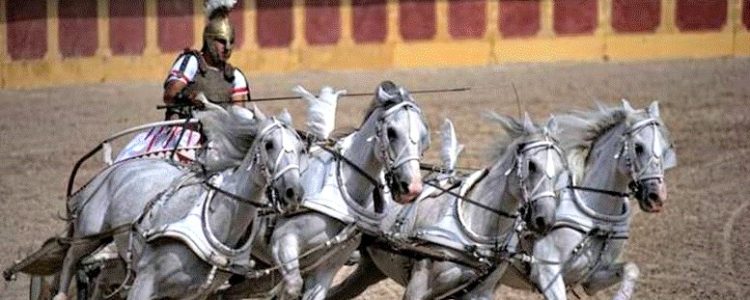What vegetable helps lumbago pain and heals sickly fish?
Pliny suggests celery or parsley as a treatment for lumbago, and reports that tossing it into a fish pond will revive sickly fish.
What percentage of Romans worked in agriculture?
Up until the first century A.D., fields were harvested manually by slaves or free farmers. According to Pliny, the Gaul's' invented a reaping machine which was adopted by the Romans. The vallus, a two-wheeled cart, was moved by an animal yoked to the draw bar frame. The harvester effectively beat the wheat and separated the chaff from the kernels. “On the vast estates in the provinces of Gaul, large frames fitted with teeth at the edge and carried on 2 wheels are driven through the grain by a pack animal, pushing from behind; torn heads fall into the frame." Natural History, XVIII.
Who drank pearls dissolved in vinegar?
"Caligula's ingenuity for reckless extravagance exceeded all the spendthrifts of the past. He would bathe in perfumed oils, hot or cold, for a novelty; drink costly pearls dissolved in vinegar; served up unnatural feasts, with gold used in preparing the bread and meat, asserting that one should either be frugal or be Caesar...." Suetonius, The Twelve Caesar's, Book 4, XXXVII.
Caligula's favorite horse was named Incitatus. What did the name mean?
Caligula's beloved steed was a white Spanish stallion. He claimed Incitatus to be a combination of the gods, and encouraged his subjects to worship him as such. Cassius Dio wrote: "Caligula use to invite Incitatus to dinner, where he would offer him golden barley and drink to his health in wine from golden goblets;...and even promised to appoint him consul, a promise that he would certainly have carried out if he had lived longer." Suetonius observed: "Caligula had even procured Incitatus a wife, a mare named Penelope."
What did the Circus Maximus winning charioteer receive as first prize?
Winning charioteers were considered stars, and were rewarded for their victories with fame, money and glory. In most cases, the owner of the chariot was not the driver, rather a family member, slave or hired professional. Racers wore the color-coded tunics of their factions, securely fastened with leather straps around their waist and across their back. Their left hand was used to steer the course, and their right to wield the whip. The famous Fuscus, a charioteer for the Green faction, was a slave who died at age 24 after winning 53 victories.
What happened at the Tarpeian Rock?
The Tarpeian Rock is a steep, 75-foot high cliff on the southern summit of the Capitoline Hill. This place of execution was cited in the Twelve Tables (VIII.23) as the place of punishment for those who "were convicted of speaking false witness." However, the Tarpeian Rock was eventually reserved for the most notorious of criminals, and its associated stigma was considered worse than the death itself. The standard method of execution in ancient Rome was by strangulation in the Tullianum (prison): "There is a place called the Tullianum, about twelve feet below the surface of the ground. It is enclosed on all sides by walls, and above it is a chamber with a vaulted roof of stone. Neglect, darkness, and stench make it hideous and fearsome to behold." Sallust, War with Catiline. (86–35 B.C.)
What is the first war mentioned in the Bible?
The first reference to war occurs not long after the call of Abram. It was a regional conflict between a number of allied kings of the North, probably occurring around 2000 B.C. In the aftermath, Abram's nephew Lot is taken captive, but is recovered by Abram and his 318 men. Genesis 14.
Whose horse had human-like hooves?
Caesar rode a remarkable war horse, famous for having feet that were very human-like. Suetonius remarked that its cloven hooves resembled toes. When the horse was foaled on Julius' private estate, the soothsayers prophesied that its master would rule the world. Reared with the greatest care, Julius was the first to mount it, for it would endure no other rider. Later, a statue of the horse was dedicated before the temple of Venus Genetrix. Suetonius, The Twelve Caesars, Book 4, LXI.
It was a capital crime to view which person from above?
"Caligula was tall and very pallid, with an ill-formed body and extremely thin neck and legs. His eyes and temples were sunken, his forehead broad and forbidding, and his hair was absent on top, though his body was very hairy. Because of this, to mention a goat, or to look upon him from a higher place as he passed by, was a capital offence..." Suetonius, The Twelve Caesars, Book 4, L.
Where were Rome's important documents kept?
The vestals kept wills, money, and important documents such as treaties and secrets of state. Their exalted position accorded them many exceptional privileges, including the ability to write and possess their own will and bequeath property without the use of a tutor (legal guardian). They had the authority to pardon prisoners and override death sentences, and were accorded civil liberties denied to Roman female citizens.
Share your Results :
Share your Results :
Share your Results :
Share your Results :
Share your Results :
Please share this quiz to view your results.
